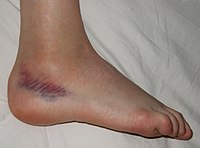
Photo from wikipedia
Collateral ligament injury of the metacarpophalangeal (MCP) joint of the fingers is underreported in the literature and widely underestimated by medical community. Here, we present results from a large series… Click to show full abstract
Collateral ligament injury of the metacarpophalangeal (MCP) joint of the fingers is underreported in the literature and widely underestimated by medical community. Here, we present results from a large series of patients and review factors influencing success of surgery. We performed a retrospective study of 46 patients who underwent surgical fixation of the MCP collateral ligament using bone anchor in an acute or chronic setting. The diagnosis was predominantly clinical based on laxity testing of the joint. We collected demographic data as well as peroperative findings and postoperative results. The MCP joint and proximal interphalangeal joint amplitude of motion were measured using a goniometer. The grip strength was evaluated using a Jamar hydraulic hand dynamometer (4MD Medical Solutions, Lakewood, NJ, USA) and was compared to the opposite hand. The stability of the collateral ligament was assessed by a stress of the MCP joint in a fully flexed position. A postoperative Quick-DASH score was available for 17 patients. This scoring system ranges from 0 (no disability) to 100 (most severe disability). We decided to perform postoperative radiography only if clinical instability remained, and radiography was not necessary in our cohort. Post-surgery, with a median follow-up of 17 months, all patients presented with a stable joint and a complete resolution of pain. The mean flexion of the MCP joint was 77.91°, and extension was a mean of 0.84°. We measured the injured grip strength at a mean of 88.52% of the opposite hand, and the mean Quick-DASH score used to evaluate disability was 9.56 on a scale of 100 (with 100 complete disability). Importantly, time from injury to surgery did not influence postoperative results. The diagnosis of MCP collateral ligament rupture is predominantly clinical based on presentation with pain and swelling of the MCP joint with a clear lateral laxity of the MCP joint in flexion. Although in our series, operative delay did not influence postoperative results and a direct repair was always achievable, some authors have described a destruction of the remnant ligament in chronic lesions of MCP joint requiring reconstructive technique. Surgical treatment of MCP collateral ligament rupture with bone anchors is a safe technique that gives reproducible positive results that are not influenced by demographic data, or time to treatment. This pathology is not rare, and a better diagnosis would increase the incidence in future reports.
Journal Title: Hand Surgery and Rehabilitation
Year Published: 2018
Link to full text (if available)
Share on Social Media: Sign Up to like & get
recommendations!